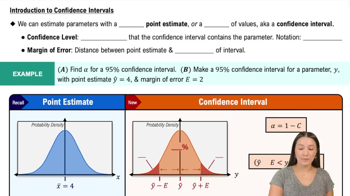Medical Malpractice In a study of 1228 randomly selected medical malpractice lawsuits, it was found that 856 of them were dropped or dismissed (based on data from the Physicians Insurers Association of America). Use the bootstrap method to construct a 95% confidence interval estimate of the proportion of lawsuits that are dropped or dismissed. Use 1000 bootstrap samples. How does the result compare to the confidence interval found in Exercise 16 “Medical Malpractice” from Section 7-1?
Table of contents
- 1. Intro to Stats and Collecting Data1h 14m
- 2. Describing Data with Tables and Graphs1h 55m
- 3. Describing Data Numerically2h 5m
- 4. Probability2h 16m
- 5. Binomial Distribution & Discrete Random Variables3h 6m
- 6. Normal Distribution and Continuous Random Variables2h 11m
- 7. Sampling Distributions & Confidence Intervals: Mean3h 23m
- Sampling Distribution of the Sample Mean and Central Limit Theorem19m
- Distribution of Sample Mean - Excel23m
- Introduction to Confidence Intervals15m
- Confidence Intervals for Population Mean1h 18m
- Determining the Minimum Sample Size Required12m
- Finding Probabilities and T Critical Values - Excel28m
- Confidence Intervals for Population Means - Excel25m
- 8. Sampling Distributions & Confidence Intervals: Proportion1h 12m
- 9. Hypothesis Testing for One Sample3h 29m
- 10. Hypothesis Testing for Two Samples4h 50m
- Two Proportions1h 13m
- Two Proportions Hypothesis Test - Excel28m
- Two Means - Unknown, Unequal Variance1h 3m
- Two Means - Unknown Variances Hypothesis Test - Excel12m
- Two Means - Unknown, Equal Variance15m
- Two Means - Unknown, Equal Variances Hypothesis Test - Excel9m
- Two Means - Known Variance12m
- Two Means - Sigma Known Hypothesis Test - Excel21m
- Two Means - Matched Pairs (Dependent Samples)42m
- Matched Pairs Hypothesis Test - Excel12m
- 11. Correlation1h 6m
- 12. Regression1h 50m
- 13. Chi-Square Tests & Goodness of Fit1h 57m
- 14. ANOVA1h 57m
8. Sampling Distributions & Confidence Intervals: Proportion
Confidence Intervals for Population Proportion
Problem 7.3b
Textbook Question
Voting Survey In a survey of 1002 people, 70% said that they voted in a recent presidential election (based on data from ICR Research Group). Voting records show that 61% of eligible voters actually did vote.
b. Find a 95% confidence interval estimate of the percentage of people who say that they voted.
 Verified step by step guidance
Verified step by step guidance1
Step 1: Identify the sample proportion (p̂) and sample size (n). The sample proportion is the percentage of people who said they voted, which is 70% or 0.70. The sample size is 1002.
Step 2: Determine the critical value (z*) for a 95% confidence level. For a 95% confidence interval, the critical value z* is approximately 1.96 (this value corresponds to the standard normal distribution).
Step 3: Calculate the standard error (SE) of the sample proportion using the formula: SE = sqrt((p̂ * (1 - p̂)) / n). Substitute p̂ = 0.70 and n = 1002 into the formula.
Step 4: Compute the margin of error (ME) using the formula: ME = z* × SE. Use the critical value z* = 1.96 and the standard error calculated in Step 3.
Step 5: Construct the confidence interval by adding and subtracting the margin of error from the sample proportion. The confidence interval is given by: [p̂ - ME, p̂ + ME].
 Verified video answer for a similar problem:
Verified video answer for a similar problem:This video solution was recommended by our tutors as helpful for the problem above
Video duration:
4mPlay a video:
Was this helpful?
Key Concepts
Here are the essential concepts you must grasp in order to answer the question correctly.
Confidence Interval
A confidence interval is a range of values, derived from sample statistics, that is likely to contain the true population parameter with a specified level of confidence, typically 95%. It provides an estimate of uncertainty around a sample statistic, allowing researchers to infer about the population from which the sample was drawn.
Recommended video:

Introduction to Confidence Intervals
Sample Proportion
The sample proportion is the ratio of the number of individuals in a sample who have a particular characteristic to the total number of individuals in that sample. In this case, it refers to the percentage of survey respondents who claimed they voted, which is essential for calculating the confidence interval.
Recommended video:

Sampling Distribution of Sample Proportion
Margin of Error
The margin of error quantifies the uncertainty in the estimate of a population parameter based on a sample. It is calculated using the standard error of the sample proportion and reflects how much the sample proportion might differ from the true population proportion, influencing the width of the confidence interval.
Recommended video:

Finding the Minimum Sample Size Needed for a Confidence Interval

 5:45m
5:45mWatch next
Master Constructing Confidence Intervals for Proportions with a bite sized video explanation from Patrick
Start learningRelated Videos
Related Practice
Textbook Question
